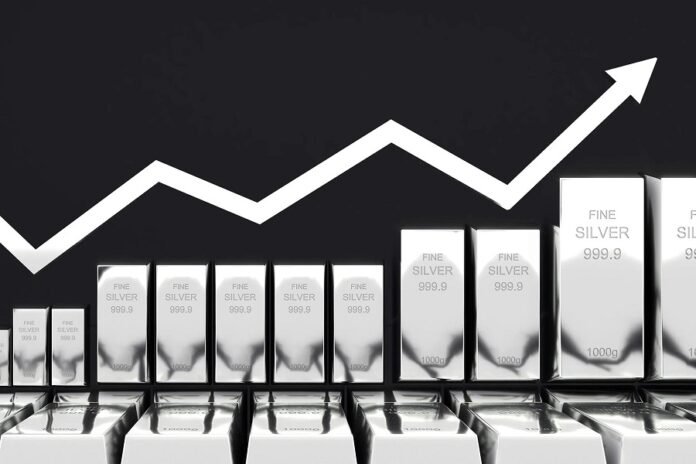Silver has been used as a means of trade and a store of worth for a very long time. Its physical properties make it unique and useful in many industries, like solar energy, electronics, medicine, and photography. There are also people who believe that it’s a safe investment against volatility in the market, inflation, and devaluation of currency.
But does this apply to Australia in 2024? What should be considered before buying it? How would you even do that? And what can we expect in the future? In this article we’ll answer all these questions and provide you with handy information and tips on how to invest your money into silver in Australia.
Key factors to consider before investing in silver
Before you decide to invest in silver, you should consider the following factors that may affect the price and demand of silver:
- Supply and demand. The price of silver is decided by how much supply there is compared to the demand there is. Several things can impact the supply and demand of silver, like mining production, industrial consumption, jewelry demand, investment demand, recycling, and geopolitical events. When there’s not enough silver available for how much people want it, the price goes up. And when there’s too much silver for what people want, then the price goes down. In 2022 we saw a 4% decline in global silver supply while demands increased by 8%, this resulted in a surplus of 80.1 million ounces according to the World Silver Survey 2023. The report also projects that supply will increase by 8% in 2023 while demand increases by 15%, this results in a deficit of 28.7 million ounces.
- The US dollar. The US dollar is what the world uses as a reference currency and it’s also used as the main currency to trade silver. So changes in its power impacts prices of silver immensely. When it’s strong then prices fall because it becomes expensive for foreign buyers who use their local currencies to buy silver. But when it’s weak then prices rise because buying with local money becomes cheaper for foreign buyers. Interest rates, inflation, economic growth, trade balance, fiscal policy, and geopolitical events are some of the factors that impact how strong or weak the dollar is.
- Inflation. Over time goods and services become more expensive and this reduces what you’re able to purchase with your money now compared to before which creates inflation. This also causes fixed-income investments like savings accounts and bonds to lose value over time which attracts investors to search for other assets that can preserve or increase value during these periods. Silver can be one of those assets since it has a high demand but limited supply that can drive up its price alongside inflation rates over time making investors view it as a hedge against inflation.
How to invest in silver in Australia
If you are interested in investing in silver in Australia, you have several options to choose from, depending on your preferences, budget, and risk appetite. Here are some of the most common ways to invest in silver in Australia:
- Buy physical silver. The most direct and tangible way to own it. You can purchase it in various forms like coins, bars, rounds, or even jewelry from trusted dealers or online retailers. Once you own it you can store it somewhere safe like a home safe, bank vault, or storage facility. The advantage of buying physical silver is that you have full control over your investment. You’re able to enjoy the sight of it and use it as a safety net in emergencies. There are disadvantages though. You’ll need to pay for premiums, shipping, insurance and storage fees which can lower your return. On top of that you’ll have to deal with the risks of theft damage and loss.
- Buy silver exchange-traded funds (ETFs). This is a more convenient and cost-effective way to invest in silver without having to own or store it physically. You can buy them from various exchanges such as the New York Stock Exchange (NYSE) or the London Stock Exchange (LSE). Essentially they are just funds that track the price of silver by holding onto futures contracts in their portfolios. On the bright side you can diversify your portfolio and access global market while enjoying lower fees and taxes than if you were to purchase physical silver. Now on the downside, you will not have ownership so forget about possessing it physically since all purchases will be digital only.
- Buy silver mining stocks or exchange-traded funds (ETFs). This is another indirect way to invest in silver by investing into companies responsible for producing or exploring them or asx silver stocks. This also gives you access into emerging markets but just as before there’s always cons that come with pros. In this case there’s two main things wrong with buying these types of stocks. First is that you’re exposed directly to their operational and financial risks such as costs with production environmental issues political instability and regulatory changes made by governments around the world. And secondly market volatility in general because everyone knows how unpredictable stocks can be.
Silver Future Forecast for 2024 and Beyond
Silver’s future is unsure. There are so many things that can affect its price and demand in the long run. Using current trends we can guess what it might look like in 2024. Here are some scenarios and results for silver down the road:
- Scenario 1: Silver surges to new highs. Silver goes wild, up high. This is what would happen if the global economy recovers from COVID-19 and starts to grow again, which will lead to an increase in demand for silver. In addition, the amount of it that’s available will shrink even more because of how difficult it is to get and production costs go up. On top of that, inflationary pressure isn’t going anywhere and the US dollar will become weaker. This scenario could push silver to new heights and even past its previous record at $49.51 per ounce in 2011. Some analysts have even predicted that silver could reach $100 or more per ounce within the next ten years .
- Scenario 2: Silver remains stable or modestly rises. This outcome assumes that the worldwide market will start recovering and growing at a slow pace from COVID-19. Which means demand for silver by investors and manufacturers will rise slightly as well. Thankfully, there’s some good news for supply since improvements in mining technology should provide just enough to keep pace with this growth. Furthermore, the inflationary pressures we’re seeing now may disappear soon and the US dollar’s value might stabilize soon making people less interested in using it to hedge investments and store value long-term. In this scenario there might be no movement at all or a bit of growth but not much beyond $20 to $30 per ounce .
- Scenario 3: Silver plunges to new lows. he entire world is already suffering from a variety of things caused by COVID-19 such as recessions, unemployment rates skyrocketing, businesses closing their doors forever along with other factors that can make recovery slow or practically nonexistent at all. Out of everything on here though, this one assumes there will be heavy drops in industrial demand for silver due to lack of business activity and investment desire from people scared out of their minds about current conditions like these . To put salt on the wound there has been a surplus of newly discovered mines . All over the place and this will completely flood the market with it and make it cheaper to buy. Even worse, the value of silver is going to become more expensive because of how strong the US dollar is becoming. In this scenario silver could drop below $10 per ounce .
Conclusion
Silver is a powerful and unpredictable metal. It can give investors the world if they know how to use it right. The benefits include portfolio diversification, fighting inflation, and tapping into the booming demand for silver in countless industries. However, these pros come with cons— it’s risky and volatile. There are so many factors that play into this and can affect its worth such as supply, demand, the US dollar, inflation, and even the global economic situation. So if you’re thinking about investing in this metal make sure you do extensive research on your own. Stay up to date on the different ways people invest in silver, and prepare for whatever 2024 may bring.
FAQs
Will Silver Go Up in 2024?
The projected prices for silver in 2024 are all over the place. Some expects average it out to $29.50 per ounce, they say this is due to the strong demand coming from green technology sectors. On the other hand, more optimistic people predict a price of $77 per ounce by 2024. The reason is that both gold and silver prices are going up. Then we have people who can’t make up their mind, some say it will be around $36.581 by the end of next year while others think it’ll reach $58.07.
What Will Silver Be Worth in 2024?
When it comes to 2024, the price of silver is difficult to predict. But what we do know is that it largely depends on things like industrial demand and economic conditions. What people are saying varies from $29.50 to around $77 or $58.07 per ounce.
What is the Silver Demand Forecast for 2025?
The demand for silver is foreseen to reach 1,155 million ounces in 2025, growing at a Compound Annual Growth Rate (CAGR) of 2.98% from 2021 to 2025. One of the reasons for it is the usage in industries, namely solar panels which could lead to a lack in supplies and raise prices even higher.
Should I Buy Gold or Silver in 2023?
When you invest in either asx gold stocks or silver, choose which one depends on your goals. Even though gold is usually the preferred option because of its worth and status as an asset, silver might outshine it in 2023 due to strong demand, according to analysts. Silver might be a riskier pick with its volatility but could reward you more if the market conditions favor it. But both are good hedges against economic uncertainty, inflation and currency devaluation. So they’re best used in a diverse portfolio.
Read Also: Is Investing in the Stock Market a Good Choice?






























































